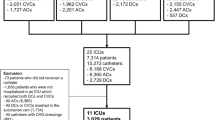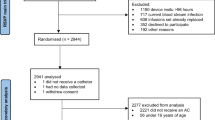Abstract
Objective
Despite the lack of evidence to support routine scheduled replacement of peripheral arterial catheters this practice continues to be widely used in many intensive care units (ICU). This study evaluated whether additional risks of catheter colonization are incurred with a conservative attitude in severely ill patients.
Design and setting
Observational study over a 18-month period in a 15-bed surgical ICU of a 1,000-bed French university-affiliated hospital.
Catheters
A total of 295 peripheral arterial catheters were inserted in 295 patients.
Measurements and main results
Hazard rates of catheters colonization (defined as quantitative culture of a catheter tip showing at least one microorganism at a concentration of 1,000 or more colony-forming units per milliliter) according to indwelling time were determined over 5-day periods by survival analysis. The mean indwelling time was 8 ± 6 days (median 6 days). Overall, 47 (16%) colonization episodes were diagnosed, leading to catheter colonization incidence density of 19.9 per 1,000 catheter-days. Risk factors for catheters colonization increase in proportion to the duration of catheter use. Hazard rates of catheter colonization were 1.0, 1.9, 3.5, 7.0, 6.0 and 5.7%, for the 111 arterial catheters left in place for 4 days or less, 5–9 days (87 catheters), 10–14 days (55 catheters), 15–19 days (27 catheters), 20–24 days (10 catheters) and more than 24 days (5 catheters).
Conclusions
Systematic replacement of peripheral arterial catheters might be useful in preventing catheter-related colonization, especially after 2 weeks of use.


Similar content being viewed by others
References
Vincent JL, Bihari DJ, Suter PM, Bruining HA, White J, Nicolas-Chanoin MH, Wolff M, Spencer RC, Hemmer M (1995) The prevalence of nosocomial infection in intensive care units in Europe. Results of the European Prevalence of Infection in Intensive Care (EPIC) Study. EPIC International Advisory Committee. JAMA 274:639–644
Mermel LA (2000) Prevention of intravascular catheter-related infections. Ann Intern Med 132:391–402
Pittet D, Tarara D, Wenzel RP (1994) Nosocomial bloodstream infection in critically ill patients: excess length of stay, extra costs, and attributable mortality. JAMA 271:1598–1601
Renaud B, Brun-Buisson C, ICU-Bacteremia Study Group (2001) Outcomes of primary and catheter-related bacteremia. A cohort and case–control study in critically ill patients. Am J Respir Crit Care Med 163:1584–1590
OGrady NP, Alexander M, Dellinger EP, Gerberding JL, Heard SO, Maki DG, Masur H, McCormick RD, Mermel LA, Pearson ML, Raad II, Randolph A, Weinstein RA (2002) Healthcare Infection Control Practices Advisory Committee. Guidelines for the prevention of intravascular catheter-related infections. Infect Control Hosp Epidemiol 23:759–769
Timsit JF (2005) Updating of the 12th consensus conference of the Société de Réanimation de langue française (SRLF): catheter related infections in the intensive care unit. Ann Fr Anesth Reanim 24:315–322
Eyer S, Brummitt C, Crossley K, Siegel R, Cerra F (1990) Catheter-related sepsis: prospective, randomized study of three methods of long-term catheter maintenance. Crit Care Med 18:1073–1079
Raad II, Umphrey J, Khan A, Truett LJ, Bodey GP (1993) The duration of placement as a predictor of peripheral and pulmonary arterial catheter infections. J Hosp Infect 23:17–26
Lorente L, Santacreu R, Martín MM, Jiménez A, Mora ML (2006) Arterial catheter-related infection of 2,949 catheters. Crit Care 10:R83
Le Gall JR, Lemeshow S, Saulnier F (1993) A new Simplified Acute Physiology Score (SAPS II) based on a European/North American multicenter study. JAMA 270:2957–2963
Raad II, Hohn DC, Gilbreath BJ, Suleiman N, Hill LA, Bruso PA, Marts K, Mansfield PF, Bodey GP (1994) Prevention of central venous catheter-related infections by using maximal sterile barrier precautions during insertion. Infect Control Hosp Epidemiol 15:231–238
Brun-Buisson C, Abrouk F, Legrand P, Huet Y, Larabi S, Rapin M (1987) Diagnosis of central venous catheter-related sepsis. Critical level of quantitative tip cultures. Arch Intern Med 147:873–877
Mimoz O, Villeminey S, Ragot S, Dahyot-Fizelier C, Laksiri L, Petitpas F, Debaene B (2007) Chlorhexidine-based antiseptic solution vs alcohol-based povidone–iodine for central venous catheter care. Arch Intern Med 167:2066–2072
Traore O, Liotier J, Souweine B (2005) Prospective study of arterial and central venous catheter colonization and of arterial and central venous catheter-related bacteremia in intensive care units. Crit Care Med 33:1276–1280
Koh DB, Gowardman JR, Rickard CM, Robertson IK, Brown A (2008) Prospective study of peripheral arterial catheter infection and comparison with concurrently sited central venous catheters. Crit Care Med 36:397–402
Band JD, Maki DG (1979) Infections caused by arterial catheters used for hemodynamic monitoring. Am J Med 67:735–741
Furfaro S, Gauthier M, Lacroix J, Nadeau D, Lafleur L, Mathews S (1991) Arterial catheter-related infections in children. Am J Dis Child 145:1037–1042
Leroy O, Billiau V, Beuscart C, Santre C, Chidiac C, Ramage C, Mouton Y (1989) Nosocomial infections associated with long-term radial artery cannulation. Intensive Care Med 15:241–246
Thomas F, Burke JP, Parker J, Orme JF Jr, Gardner RM, Clemmer TP, Hill GA, MacFarlane P (1983) The risk of infection related to radial vs femoral sites for arterial catheterization. Crit Care Med 11:807–812
Rijnders BJ, Van Wijngaerden E, Wilmer A, Peetermans WE (2003) Use of full sterile barrier precautions during insertion of arterials catheters: a randomized trial. Clin Infect Dis 36:743–748
Chaiyakunapruk N, Veenstra DL, Lipsky BA, Saint S (2002) Chlorhexidine compared with povidone–iodine solution for vascular catheter-site care: a meta-analysis. Ann Intern Med 136:792–801
Singh S, Nelson N, Acosta I, Check FE, Puri VK (1982) Catheter colonization and bacteremia with pulmonary and arterial catheters. Crit Care Med 10:736–739
Rijnders BJ, Van Wijngaerden E, Peetermans WE (2002) Catheter-tip colonization as a surrogate end point in clinical studies on catheter-related bloodstream infection: how strong is the evidence? Clin Infect Dis 35:1053–1058
Bouza E, Alvarado N, Alcalá L, Sánchez-Conde M, Pérez MJ, Muñoz P, Martín-Rabadán P, Rodríguez-Créixems M (2005) A prospective, randomized, and comparative study of 3 different methods for the diagnosis of intravascular catheter colonization. Clin Infect Dis 40:1096–1100
Author information
Authors and Affiliations
Corresponding author
Rights and permissions
About this article
Cite this article
Khalifa, R., Dahyot-Fizelier, C., Laksiri, L. et al. Indwelling time and risk of colonization of peripheral arterial catheters in critically ill patients. Intensive Care Med 34, 1820–1826 (2008). https://doi.org/10.1007/s00134-008-1139-z
Received:
Accepted:
Published:
Issue Date:
DOI: https://doi.org/10.1007/s00134-008-1139-z




